Istanbul
Istanbul is perhaps most famous as the city which straddles two continents, Asia and Europe, and the metropolis is an intriguing blend of European near-Eastern social norms and exotic Asian-Middle Eastern culture.
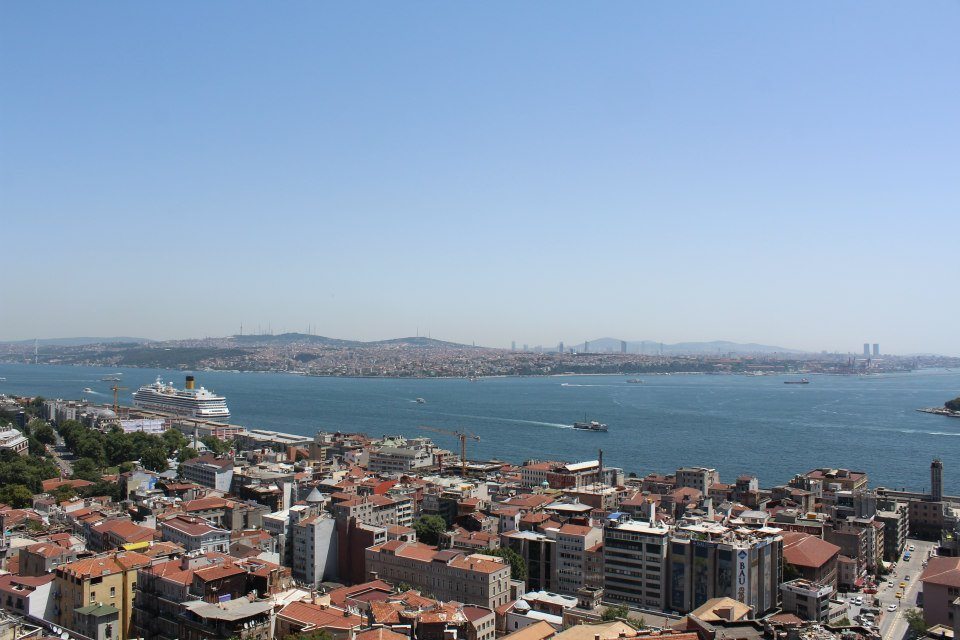
Istanbul and the Bosphorus from Galata Tower, the Asian side is the far shore
We arrived in Istanbul’s huge Ataturk International Airport mid-week, in time to attend a friend’s wedding. Driving from the airport to the city centre, we whizzed pas Soviet-style apartment blocks, magic castle-esque mosques and giant shopping malls. Arriving at the hotel, we quickly discovered a city which was wide awake, dining out mid-week, or breaking fast during the month of Ramadan. Most of Istanbul’s attractions lie on the European side of the city, and we were well placed with the W Hotel just near Taksim Square, one of the city’s many centres. Just down the road from us was the Bosphorus, the relatively narrow strait of water which connects the Mediterranean Sea to the Black Sea, and which separates European Turkey from Asian Turkey.
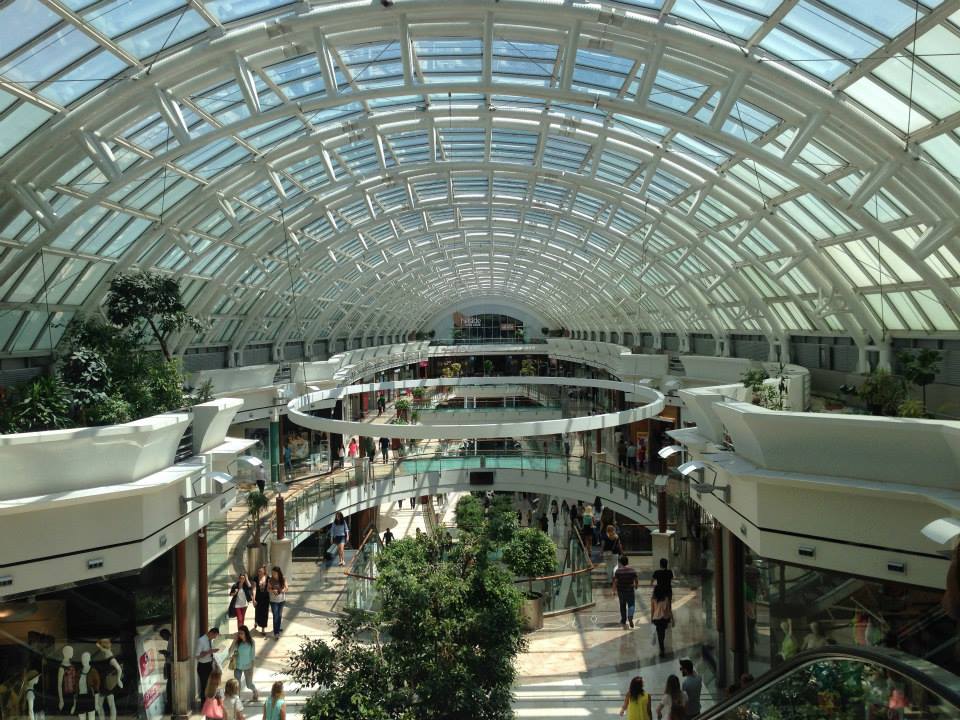
Istinye Park Mall, Istanbul
Our first day in Istanbul was something of a recovery day for us – we had been travelling for a week at this point and were attending the wedding that evening anyway. so we woke up late then went shopping. Istiniya Park is a large shopping mall in the north of Istanbul with all the usual branded stores and some interesting cafes too. I was won over by the chocolate custard thickshake dispensed by one place in particular. Back in the city that evening, we attended a delightful wedding and reception by the Bosphorus, in the shadow of one of the two bridges to connect the continents. The wedding was a hybrid Turkish – Australian affair, with Turkish dancers performing what appeared to be a Middle Eastern take on “Zorba the Greek”.
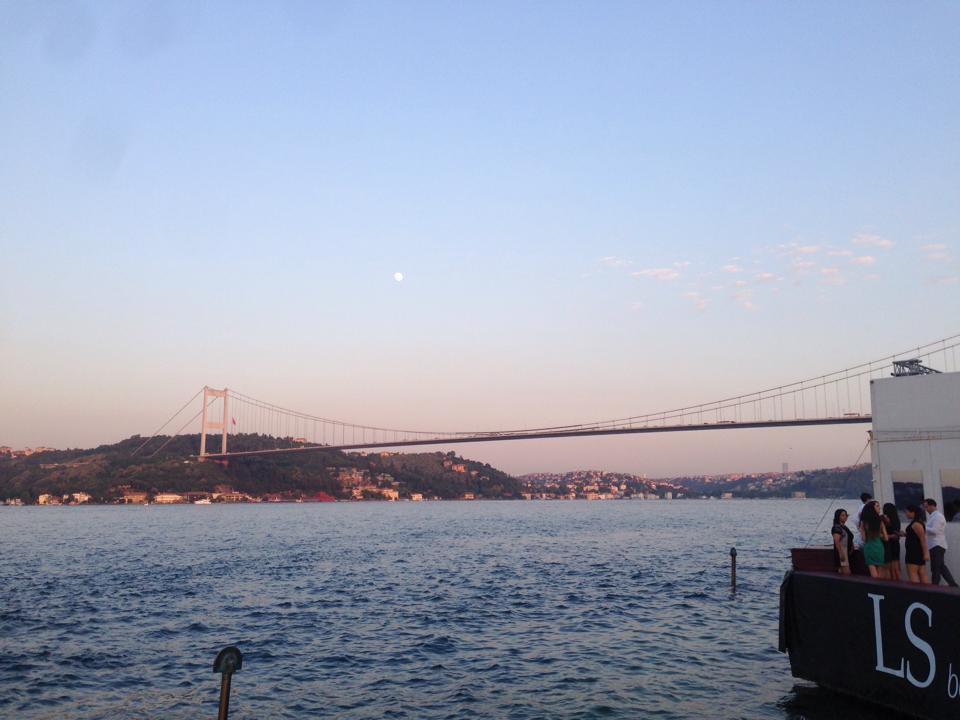
Fatih Sultan Mehmet Bridge crosses from the European to the Asian side of Istanbul, right near the wedding venue!
Istanbul is Turkey’s face to Europe, and it is quite easy to see why many visitors consider it to be a European city. The day after the wedding we took a walk through Taksim Square and Beyoglu, the historic hilltop suburb filled with cafes and juice bars. The quaint tram from Taksim to Beyoglu rattles along the pedestrian mall, and fashion stores and bakeries abound. Walking through here, one could easily be in one of Paris’ older arrondissements, the old city of Lisbon, or even a piazza in Rome. Thwarting Turkey’s bid to be considered “European” (both in nomenclature and the political arena) is the profusion of mosques in Beyoglu too. In fact it’s not the mosques which are the problem so much as what they represent; 99% of Turkish people are Muslim, a whopping 90% of Turkey’s land lies across the bridge in Asia, and the country shares borders with Iran, Syria and Iraq. Climbing Galata Tower, a 13th century watch tower for the city, the skyline is studded with minarets as well as modern business towers – a true dynamism that is in fact missing from many European cities. Chic-looking women, who wouldn’t look out of place walking the streets of Barcelona, sip coffee and chat with each other while across the road an elderly man fingers his prayer beads and waits for the call to prayer to break his Ramadan fast for the evening. Dapper young men head from the office to a really cool bar, while elderly women in their headscarves waddle along their arms full of groceries.
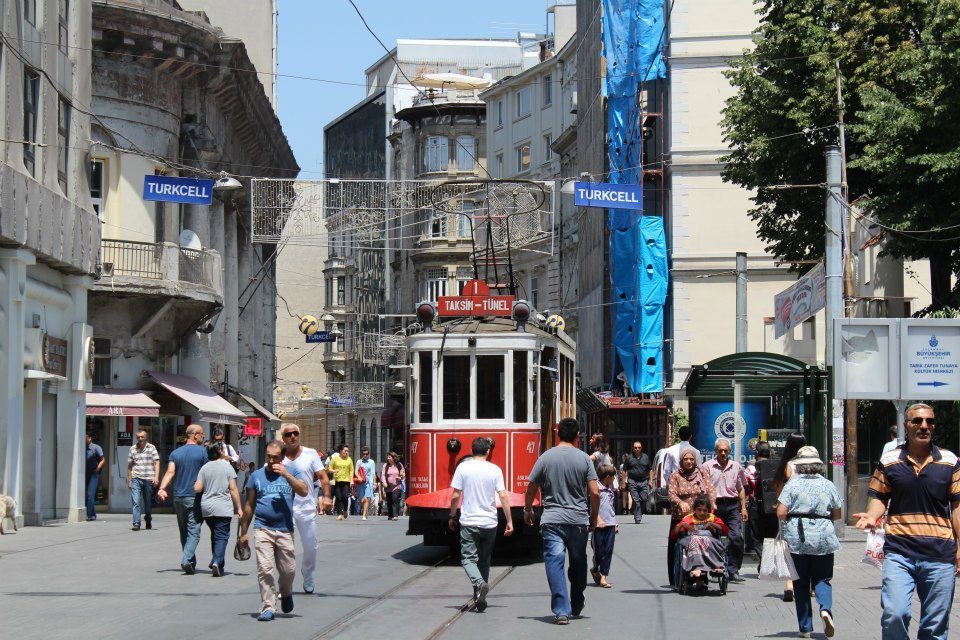
The Taksim – Beyoglu Tram, Istanbul
Our third day in Istanbul was the day we visited Sultanahmet, the historic heart of Istanbul, and home to all those mosques and monuments that you’ve read about. Our first stop was Sultan Ahmet Mosque, named after the the 17th century sultan who ruled from Constantinople (the old name for Istanbul). Sultan Ahmet Mosque is sometimes referred to as “The Blue Mosque” because of some blue tiles on the interior of its dome, although truth be told, there are much more prominent colours visible in its mosaic work. Expansive chandeliers hang low from the cavernous ceiling; the prayer hall is lit by hundreds of glass bulbs, which were once lanterns to be lit by the mosque’s caretakers. We managed to slip in just as prayer time was finishing, and I prayed zuhur namaz (midday prayer) in what is considered to be one of the most beautiful religious buildings in the world.
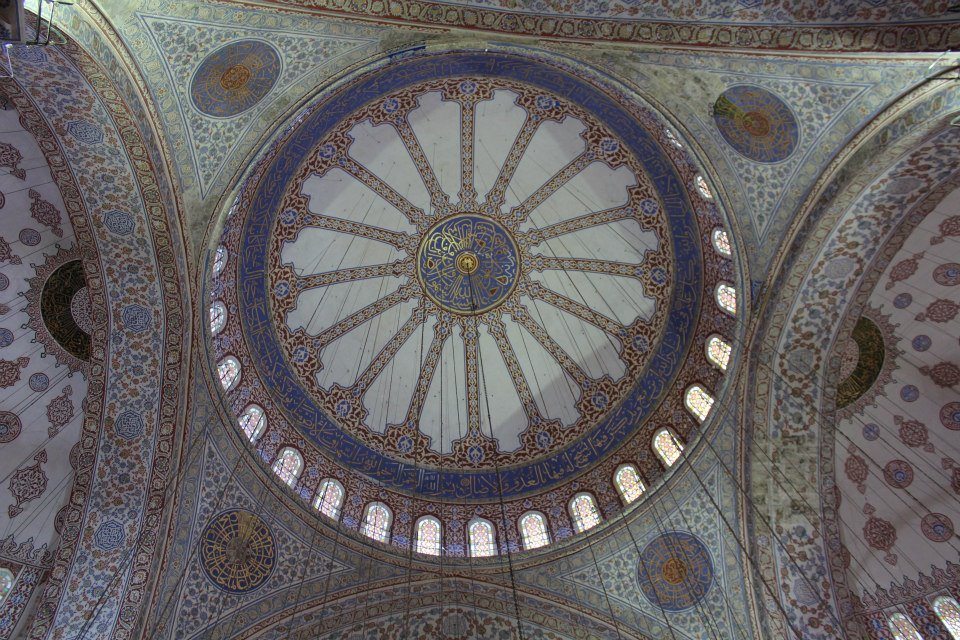
The domed ceiling of Sultan Ahmet Mosque (Blue Mosque)
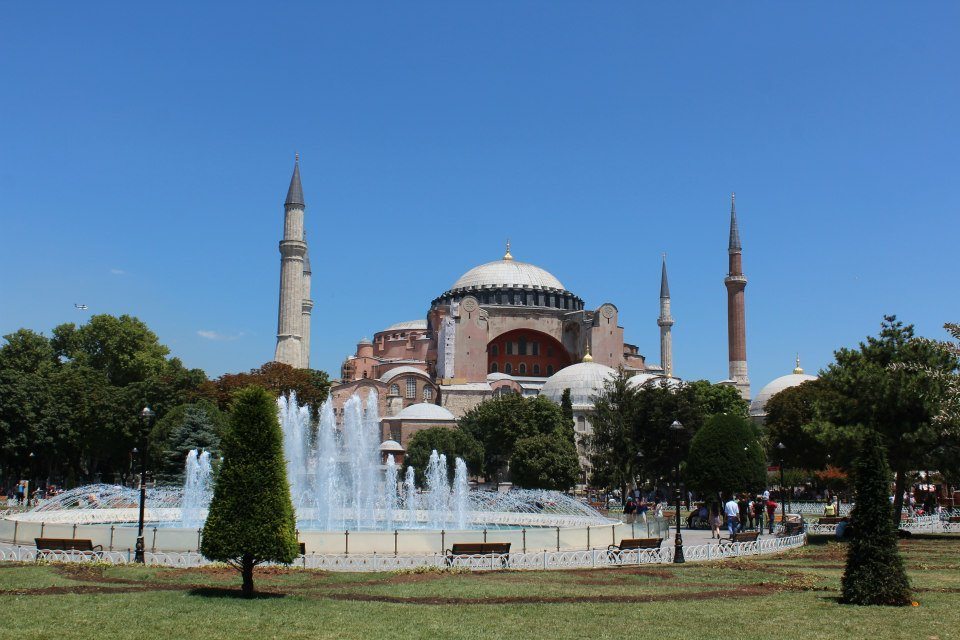
Aya Sofya, Istanbul
Across from Sultan Ahmet Mosque is the equally impressive Aya Sofya (also spelled Hagia Sophia). Once Istanbul’s principal cathedral, it became a mosque in 1453 after the sultan’s conversion to Islam. In the transformation to a Muslim prayer hall some adjustments were made, such as covering frescoes and paintings of Jesus (Jesus is a prophet in Islam, known as “Isa” in Arabic. Islamic law does not allow for depiction of prophets, lest their message be diminished in the effort to portray their physical appearance. This rule applies most strictly to the Prophet Muhammad ﷺ, but is usually extended to the Prophet Isa / Jesus ﷺ as well). However once the necessary alterations had been made, the Sultan of Constantinople allowed Christians to continue praying in Aya Sofya, alongside the newly converted Muslim population. Aya Sofya is therefore not simply an spectacular structure, but is drenched in religious history and is an impressive landmark in the annals of religious tolerance.
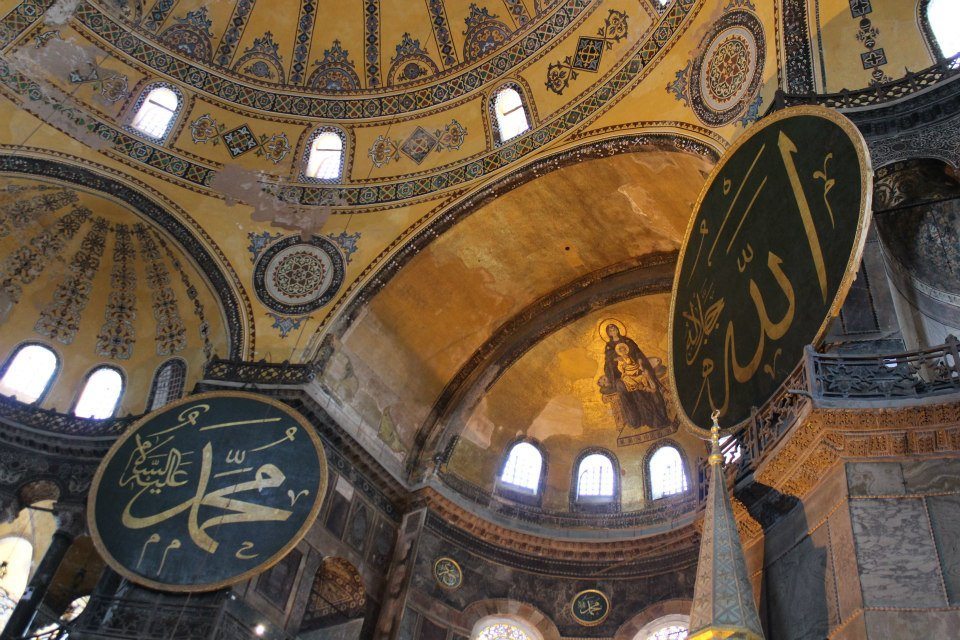
Inside Aya Sofya, both Islamic and Christian motifs can be seen
The building is now officially a museum; some of the pictures of Jesus have been uncovered, and no-one prays there due to a complete lack of pews, prayer mats, or space generally between then hoarded of tourists who walk through). That said, most people who visit spend most of their time staring at the incredible domed ceiling rather than looking at the artistic exhibits that line the walls at eye level. We almost went to Basilica Cistern, an underground water tank, but decided against it as I had already visited it once, and a storm of apocalyptic proportions seemed to be building. We made it back to the hotel in time, and later that night took a walk around the buzzing markets which were doing a rolling trade in post-iftaar sales.
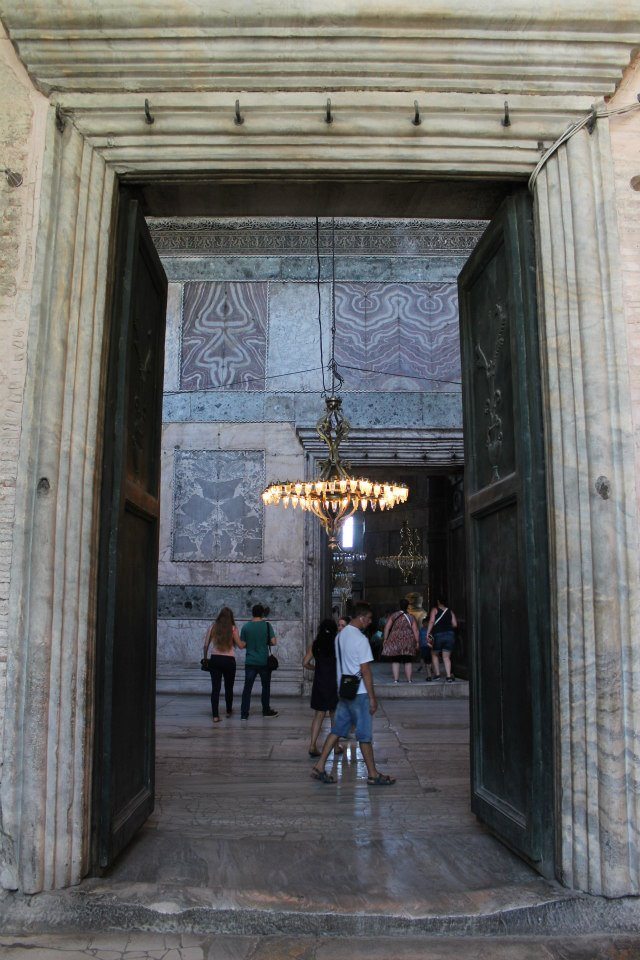
Entrance to Aya Sofya, Istanbul
Essential Stats
Culture shock: 5/10
Language difficulty: 6/10
Quality of food: 8/10
Cost: 5/10
Physical demand: 4/10
Advice and warnings
Istanbul is not a dangerous city, but it pays to know three important things. Firstly, like any large city it has its own share of touts and scammers in the touristy areas. Use common sense, and if you go to the bazaar, bargain hard. Secondly, as the largest city in a nation at the crossroads (in more ways than one), Istanbul sees occasional bouts of political violence – this usually takes the form of demonstrations, but in June 2013 turned violent. If you see a protest, stay away, and if you are in an area with a heavy police presence (like Taksim Square), use common sense – no taking happy snaps of police posts or guarded government buildings. Finally, despite appearances (and perhaps ambitions), Turkey still has a conservative undercurrent owing to its Islamic heritage. There’s no need to wear special clothes or drastically alter one’s behaviour in the street, but remember that not all Turkish people share the same Western liberal outlook, and that a mosque is still a sacred place and does call for modest clothing and a level of decorum.
Check Smart Traveller or the British Foreign Office for more comprehensive warnings.
Visas
Australians purchase a Turkish visa on arrival at Istanbul’s Ataturk International Airport for €50. Pakistanis must pay PKR 6000 – the process takes around one month and a long list of documents is required. See the Turkish Embassy in Islamabad for details. Applications in India cost INR 3850, and could take several weeks. Apply through the Indian Turkish Visa VFS Service.
Getting there and around
Emirates flies to Istanbul via Dubai daily.
Melbourne (from $1,644 return)
Lahore (from PKR 82,254 return)
Sydney (from $1,693 return)
Chennai (from INR 62,265 return)
Accommodation
We stayed at the pleasant W Hotel. If you’re looking for something a bit easier on the wallet, there are plenty of great budget and economy options available through HostelWorld.com.




Awesome place and as awesome was the blog.loved it
Thanks for reading!!! Stay tuned, there’s more info from Istanbul later this week in sha Allah 🙂
I’m still so bummed we didn’t have the time to visit Turkey on this trip; I would LOVE to visit Istanbul some day. I discovered on our trip that I’m a huge fan of Islamic architecture, so there are so many buildings there that I would love to see! Your pictures of the Aya Sofya are killing me!
So next time I’ll plan a trip to Galle, and you plan a trip to Turkey!! 😀
Hey Tim. Looks like an awesome place to visit. It hasnt been on my travel bucket list, but I think I should maybe change that. Your pictures are great, I love the detail in the Mosque. Thanks for the travel tips too!
Thanks for reading and commenting Anna! It’s so beautiful – and the pictures really don’t reflect the grandeur of it! It should definitely be on your bucket list 🙂
I’ve always wanted to plan a trip to Turkey! I loved your pictures of the details in Sultan Ahmet Mosque and Aya Sofya. 🙂
Thanks for stopping by again!! You must visit some day – it’s awesome 🙂
A marvellous place to visit.
you mentioned that Aya Sofya is a museum, which was cathedral and then a mosque in the past. Is it part of Sultan Ahmet mosque?
No, actually Sultan Ahmet Mosque was built nearby, legend has it, with the intention to be more beautiful than Aya Sofya! Sultan Ahmet Mosque is still a functioning mosque, whereas Aya Sofya has paintings and exhibits on the bottom and first floors. Thanks for reading – I hope you can make it there some day!!